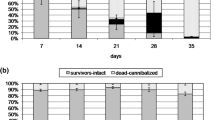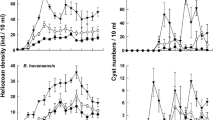Abstract
Feeding and passage of nutrient particles through the digestive tract of the rotifer Brachionus plicatilis was examined using the following types of particles: yeast cells, mammalian (human, bovine, ovine) erythrocytes and erythrocyte-ghosts. The decrease of erythrocytes within the medium was found to follow first order kinetics. The rate constant was influenced by the density of rotifers, as well as by the initial density of particles in suspension at the beginning of the experiment. Passage of particles through the digestive tract depended on the supply of fresh particles taken up by the wheel organ. Passage time approximately doubled when the rotifers had no access to fresh particles. On provision of fresh particles, the contents of the digestive tract were expelled even if they included absorbable substances. The contents of the digestive tract of B. plicatilis can be quickly and easily exchanged by introducing a new type of particle to the medium. By replacing fluorescence-labelled erythrocyte ghosts with unlabelled ghosts, residual fluorescence indicating absorptive processes could be demonstrated.
Similar content being viewed by others
References
Bing, D. H., J. G. M. Weyand & A. B. Stavitsky, 1967. Hemagglutination with aldehyde-fixed erythrocytes for assay of antigens and antibodies. Proc. Soc. Exp. Biol. Med. 124: 1166–1170.
Bogdan, K. G., J. J. Gilbert & P. L. Starkweather.1980. In situ clearance rates of planktonic rotifers. Hydrobiologia 73: 73–77.
Clement, P., J. Amsellem, A.-M. Cornillac, A. Luciani & C. Ricci, 1980. An ultrastructural approach to feeding behaviour in Philodina roseola and Brachionus calyciflorus (rotifers) III. Cilia and muscles. Conclusions. Hydrobiologia 73: 137–141.
Doohan, M, 1973. An energy budget for adult Brachionus plicatilis (Rotatoria). Oecologia 13: 351–362.
Haney, J. F., M. Brauer & G. Nürnberg, 1986. Feeding and egestion rates of individual zooplankton using Cerenkov counting. Hydrobiologia 141: 165–174.
Hansen, B., T. Wernberg-Moller & L. Wittrup, 1997. Particle grazing efficiency and specific growth efficiency of the rotifer Brachionus plicatilis (Müller). J. exp. mar. Biol. Ecol. 215: 217–231.
Hara, K., H. Arano & T. Ishihara, 1984. Some enzymatic properties of alkaline proteases of the rotifer Brachionus plicatilis. Bull. Japan. Soc. Sci. Fish. 50: 1611–1616.
Hara, K., H. Pangkey, K. Osatomi, K. Yatsuda, A. Hagiwara, K. Tachibana & T. Ishihara, 1997. Some properties of ?-1,3-glucan hydrolyzing enzymes from the rotifer Brachionus plicatilis. Hydrobiologia 358: 89–94.
Hino, A. & R. Hirano, 1984. Relationship between body size of the rotifer Brachionus plicatilis and the minimum Size of particles ingested. Bull. Japan. Soc. Sci. Fish. 50: 1139–1144.
Johnson, G. D. & E. J. Holborow, 1986. Preparation and use of fluorochrome conjugates. In Weir, M. (ed.), Immunochemistry. Blackwell, Oxford: 1–21.
Kleinow, W. & K. Kühle, 1984. Zum pH-Optimum hydrolytischer Enzyme und zum pH-Milieu im Verdauungstrakt bei Brachionus plicatilis (Rotatoria). Verh. Dtsch. Zool. Ges. 77: 299.
Kleinow, W., N. Lindemann & S. Köhler, 1997. Investigation of food uptake of Brachionus plicatilis (Rotatoria) by means of suspended erythrocytes. Verh. Dtsch. Zool. Ges. 90: 112.
Kleinow, W., H. Wratil, K. Kühle & B. Esch, 1991. Electron microscope studies of the digestive tract of Brachionus plicatilis. Zoomorphology 111: 67–80.
Korstad, J., O. Vadstein & I. Olsen, 1989. Feeding kinetics of Brachionus plicatilis fed Isochrysis galbana. Hydrobiologia 186/187 (Dev. Hydrobiol. 52): 51–57.
Kühle, K. & W. Kleinow, 1985. Measurements of hydrolytic enzymes in homogenates from Brachionus plicatilis (Rotifera). Comp Biochem Physiol [B]. 81 B: 437–442.
Kühle, K. & W. Kleinow, 1989. Localization of hydrolytic enzyme activities within cellular fractions from Brachionus plicatilis (Rotatoria). Comp Biochem Physiol [B]. 93 B: 565–574.
Kühle, K. & W. Kleinow, 1990. Glycosidases in Brachionus plicatilis (Rotifera). Comp Biochem Physiol [B]. 95 B: 393–402.
Neuhoff, V, 1973. Production of Capillary Pipettes. In Neuhoff, V. (ed.). Micromethods in Molecular Biology. Springer-Verlag. Berlin, Heidelberg, New York: 407–409.
Ooms-Wilms, A. L., G. Postema & R. D. Gulati, 1993. Clearance rates of bacteria by the rotifer Filinia longiseta (Ehrb.) measured using three tracers. Hydrobiologia 255/256 (Dev. Hydrobiol. 83): 255–260.
Rothhaupt, K. O, 1995. Algal nutrient limitation affects rotifer growth rate but not ingestion rate. Limnol. Oceanogr. 40: 1201–1208.
Salt, G. W., 1987. The components of feeding behavior in rotifers. Hydrobiologia 147 (Dev. Hydrobiol. 42): 271–281.
Starkweather, P. L., 1980. Aspects of the feeding behaviour and trophic ecology of suspension-feeding rotifers. Hydrobiologia 73: 63–72.
Starkweather, P. L. & J. J. Gilbert, 1977 a. Radiotracer determination of feeding in Brachionus calyciflorus: The importance of gut passage times. Arch. Hydrobiol. Beiheft 8: 261–263.
Starkweather, P. L. & J. J. Gilbert, 1977 b. Feeding in the Rotifer Brachionus calyciflorus II. Effect of Food density on Feeding Rates using Euglena gracilis and Rhodotorula glutinis. Oecologia 28: 133–139.
Starkweather, P. L. & P. E. Kellar, 1983. Utilization of cyanobacteria by Brachionus calyciflorus: Anabaena flos-aquae (NRC-44-1) as a sole or complementary food source. Hydrobiologia 104: 373–377.
Teshima, S., A. Kanazawa & M. Sakamoto, 1981. Attempt to culture the rotifers with microencapsulated diets. Bull. Japan. Soc. Sci. Fish. 47: 1575–1578.
Vadstein, O., G. Oie & I. Olsen, 1993. Particle size dependent feeding by the rotifer Brachionus plicatilis. Hydrobiologia 255/256 (Dev. Hydrobiol. 83): 261–267.
Wallace, R. L. & P. L. Starkweather, 1983. Clearance rates of sessile rotifers: In situ determinations. Hydrobiologia 104: 379–383.
Wethmar, C. & W. Kleinow, 1993. Characterization of a 27 kDa Endopeptidase and Detection of a Proteinase-Inhibitor in Homogenates of Brachionus plicatilis (Rotifera). Comp Biochem Physiol [B]. 106: 359–368.
Author information
Authors and Affiliations
Corresponding author
Rights and permissions
About this article
Cite this article
Lindemann, N., Kleinow, W. A study of rotifer feeding and digestive processes using erythrocytes as microparticulate markers. Hydrobiologia 435, 27–41 (2000). https://doi.org/10.1023/A:1004029304590
Issue Date:
DOI: https://doi.org/10.1023/A:1004029304590




